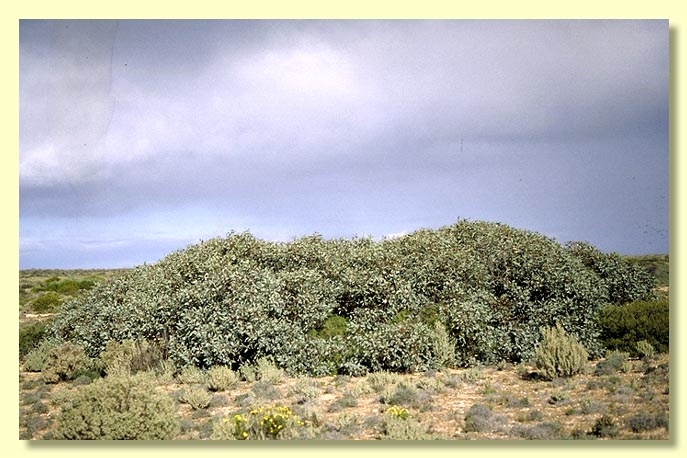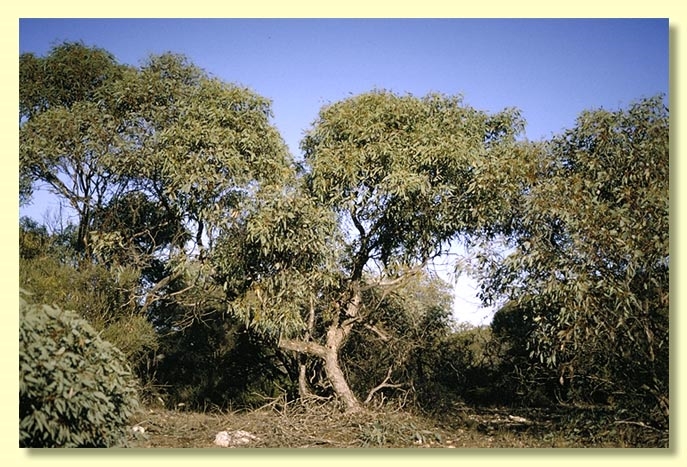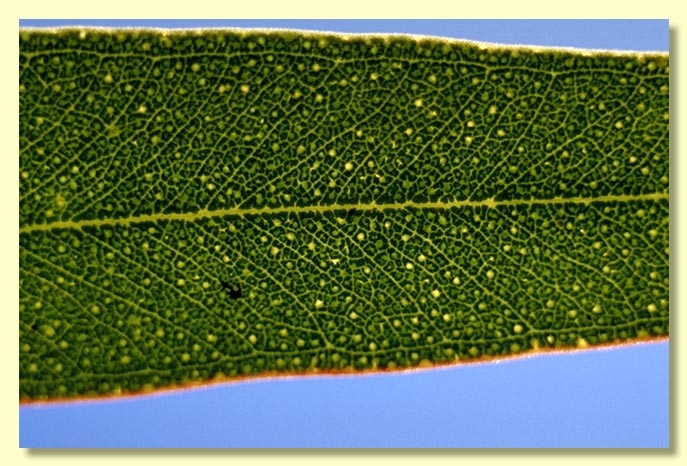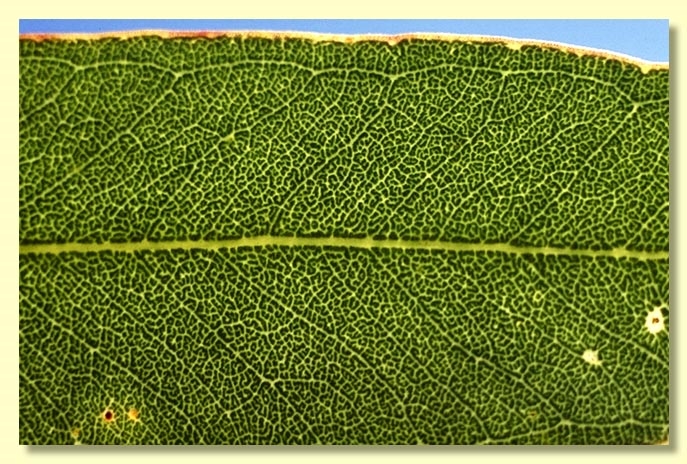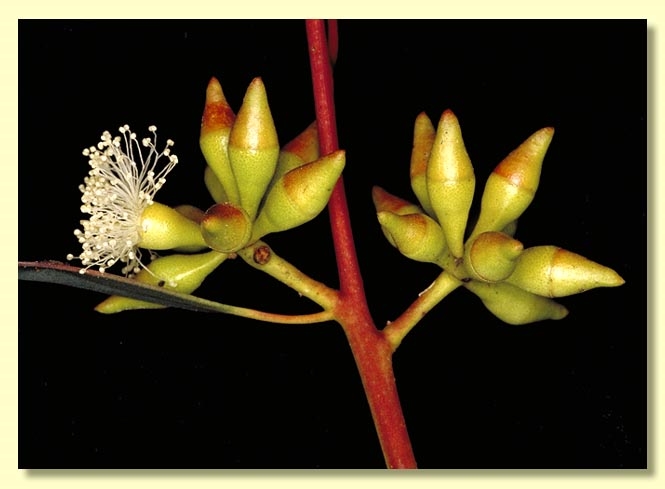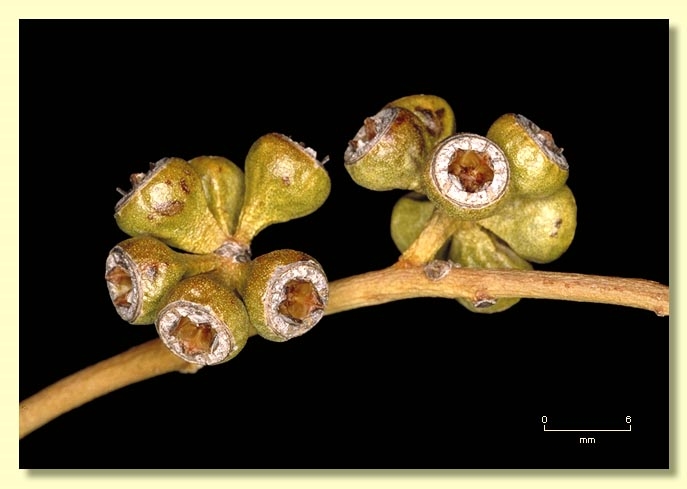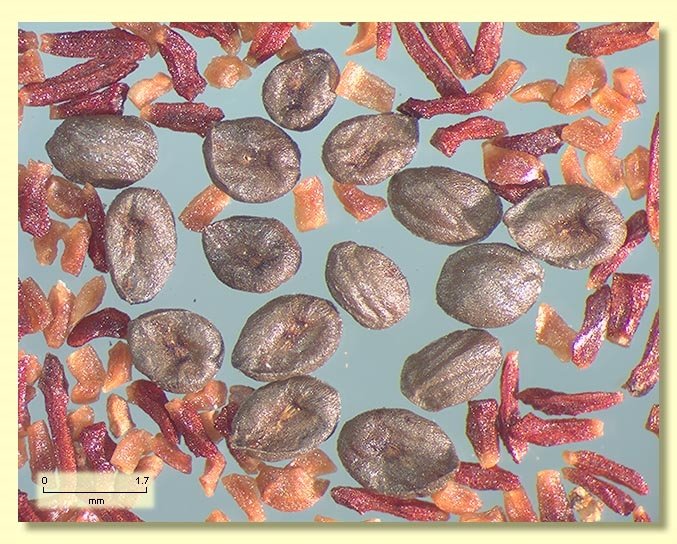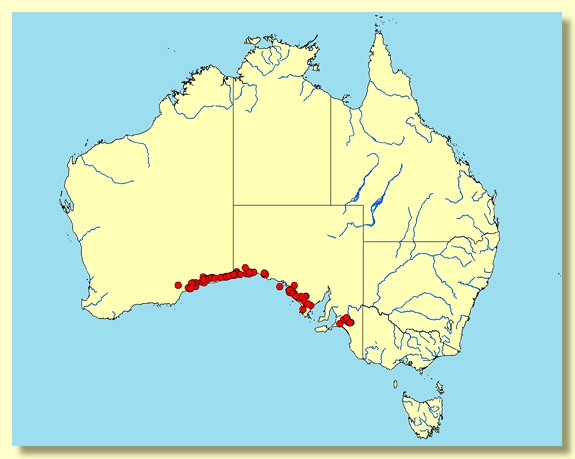Euclid - Online edition
Eucalyptus yalatensis
Eucalyptus | Symphyomyrtus | Bisectae | Destitutae | Subulatae | Decussatae
T: South Australia: 17 km SSE of Yalata, (31° 38'S 131° 58'E), 27 July 1969, B.Copley 2624; holo: AD.
Bark rough, grey to grey-brown to white, box-type or flaky, on part or all of stems, often extending to branches ca 5 cm diameter; smooth above, pale grey to pink-salmon or pale brown.
Branchlets lacking oil glands in the pith.
Juvenile growth (coppice or field seedlings to 50 cm): stems square to rounded in cross-section; juvenile leaves sessile, opposite or sub-opposite for ca 10–20 nodes, becoming petiolate and alternate, ovate, 4.3–8 cm long, 1.4–4 cm wide, base truncate to rounded at first then tapering, dull, grey-green.
Adult leaves alternate, petioles 1–2 cm long; blade lanceolate, (5)6–12 cm long, 0.9–2.2 cm wide, base tapering, concolorous, dull, blue-green to grey-green to sometimes glaucous (rarely green), side-veins at an acute or wider angle to midrib, reticulation dense to very dense, intramarginal vein remote from margin, oil glands few, intersectional or obscure.
Inflorescence axillary, unbranched, peduncles 0.3–1 cm long, buds 9 or ?11, pedicellate, pedicels 0.2–0.5 cm long. Mature buds fusiform to ovate (0.7–1.2 cm long, 0.3–0.6 cm wide), yellowish, scar present, operculum long and narrowly conical, rarely slightly beaked (0.4–0.8 cm long), stamens irregularly flexed, anthers oblong to globoid, subversatile, basifixed, dehiscing by lateral pores, locules 3 or 4, the placentae each with 4 vertical rows of ovules. Flowers creamy white, sometimes pale yellowish.
Fruit pedicellate, pedicels 0.1–0.5 cm long, hemispherical to truncate-globose, 0.4–0.7 cm long, 0.4–0.7 cm wide, the rim thick with disc usually level or slightly descending, valves 3 or 4, exserted and often surmounted by persistent, fragile style remnants.
Seeds grey-brown, glossy, 1–2 mm long, ovoid to flattened-ovoid, dorsal surface smooth, sometimes with prominent longitudinal furrows, hilum ventral.
Cultivated seedlings (measured at node 10): cotyledons Y-shaped (bisected); stems square in cross-section; leaves opposite, sessile, ovate, bases rounded to truncate, 1.3–6.5 cm long, 0.8–3 cm wide, dull grey-green to green to sometimes glaucous.
Flowering has been recorded in January, August, September, October, November and December.
A mallee extending from the western edge of the Nullarbor in Western Australia to western areas of the Eyre Peninsula, South Australia, with further disjunct populations east of Tailem Bend where it is rare and can be seen between Coomandook and Sherlock. On the Nullarbor it is more commonly seen as a tumbledown mallee but becomes more erect in habit in the eastern populations. The bark is rough, grey and the adult leaves dull greyish.
Eucalyptus yalatensis belongs in Eucalyptus subgenus Symphyomyrtus section Bisectae subsection Destitutae because buds have two opercula, cotyledons are Y-shaped and branchlets lack oil glands in the pith. Within this subsection E. yalatensis is part of the large taxonomic series Subulatae further characterised by globoid basifixed anthers, grey smooth seeds with shallow longitudinal furrows, and fruit with persistent exserted style remnants. Series Subulatae is divided principally into four subseries based on the juvenile leaves, one with spiral, crowded seedling phyllotaxis (subseries Spirales), another with decussate and decurrent seedling leaves (series Decurrentes), another with decussate non-decurrent seedling leaves (subseries Decussatae), and a fourth with disjunct, petiolate seedling leaves (subseries Oleaginae).
Eucalyptus yalatensis is part of subseries Decussatae. Within this group it is closest to E. socialis and E. aspersa, which differ by the more erect habit, greener leaves that may be dull or glossy, buds with the operculum usually long and beaked and the fruit with a thinner rim.
Outside the subseries Decussatae, E. yalatensis maybe confused with E. eremicola subsp. peeneri from the Great Victoria Desert, which belongs to another subseries in the Subulatae, namely series Oleaginae where the juvenile leaves which are narrow and more or less alternate and the mature buds bluntly ovoid (opposite, sessile and broad juvenile leaves and biconic-fusiform buds in E. yalatensis).
In places on the Nullarbor plain, E. yalatensis can have adult leaves that are greener than usual and in these situations can then be confused with E. oleosa which can be distinguished by its glossy adult leaves (always dull in E. yalatensis).

